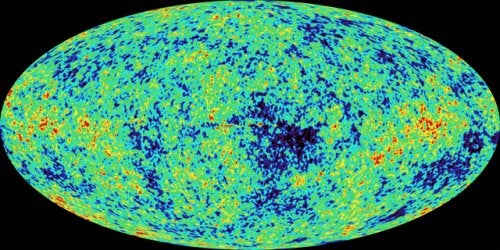A new analysis of the cosmic microwave background (CMB) radiation, the famous “echo” of the Big Bang, has revealed strange anomalies that may challenge the popular “inflation” model of the early universe.
The findings, by physicists at Case Western Reserve University in Cleveland and the European Center for Nuclear Research (CERN) in Geneva, are based on data from the Wilkinson Microwave Anisotropy Probe (WMAP), which began mapping the CMB in fine detail in 2001. The team claims to have found a correlation between the “hot” and “cold” regions of the CMB and the orientation and motion of our solar system.
Of course, the correlation could be a fluke: The patterns that Starkman and his colleagues found might be aligned with our solar system by accident. But, he says, it’s more likely that something within our solar system is producing or absorbing microwaves — and that anyone doing cosmology would have to take into account such local contamination. “None of us believe that the universe knows about the solar system, or that the solar system knows about the universe,” Starkman says.
The correlation involves the largest-scale fluctuations of the CMB. If some of those large-scale fluctuations are a local, rather than a cosmological, phenomenon, it would mean the truly cosmological large-scale fluctuations are even less intense than previously thought.
Inflation, the leading theory of the early universe, predicts the CMB fluctuations should be equally intense at all scales. Consider an analogy with a musical instrument. When you hit a drum, you hear many tones at the same time – a primary tone as well as many overtones, or harmonics. Inflation predicts all the overtones in the CMB should be equally intense. Instead, “We’re missing the bass,” Starkman says. “And what bass there is seems to be not generated by the universe, but by something local.”
Astronomers already knew large-scale CMB fluctuations are weaker than those at small scales, and this finding would indicate they’re weaker still, according to Starkman. Therefore, inflation may have to be tweaked again in order to accommodate the finding.
Starkman, coauthor Dominik Schwarz of CERN, and two colleagues at Case Western describe their results in a paper published in the November 26, 2004, issue of Physical Review Letters.
Other physicists are responding with caution to the finding.
“There is no way to judge the real significance of such a result,” says Charles Bennett of NASA’s Goddard Space Flight Center in Greenbelt, Maryland, leader of the WMAP team.
It all depends on how we perceive chance, and how we evaluate probabilities, Bennett says. The alignments seen in the CMB may seem unlikely, he says, but that doesn’t necessarily mean they require new physics to explain them.
He offers an analogy: Suppose a leaf falls from a tree and hits the ground beside your feet just as you pass the tree. “Had you computed, ahead of time, the probability of that particular leaf, on that particular tree falling at that particular moment, and hitting the ground at that particular spot on the ground, you would have found an exceeding low probability of such a series of occurrences,” he says. “However, when this sort of thing happens in the real world, you do not conclude that your data is flawed or that the laws of physics are invalid. Rather, you conclude that improbable things happen frequently because there are lots of opportunities for them to occur.”
In other words, says Bennett, the newly discovered CMB correlations are most likely the product of chance. “There may be something to it, but you can’t tell without additional information.”
Craig Hogan, a physicist at the University of Washington in Seattle, is equally cautious. “The precise directional coincidences with solar system alignments are certainly thought-provoking,” Hogan says. “It may look like a ‘smoking gun,’ but the real evidence of local systematics insinuating themselves in some subtle way has to come from a closer look at the actual data.” He says he is “going with the fluke hypothesis for now.”










